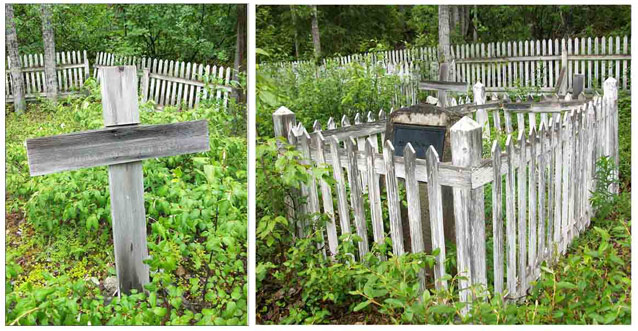
NPS / Mike Townsend In 1908, Edward Donaldson was the first to be buried at Kennecott Cemetery during the early days of settlement at the Kennecott Mill Town. Used for the next thirty years, the cemetery represents a period of life, development, and eventual decline at the Kennecott Mines and Mill Town. The final burial was in 1938, as the Kennecott mining operations closed. The cemetery presents the social history and cultural practices of the remote Alaska mining community.

NPS / Mike Townsend The Kennecott Cemetery is located a quarter mile south from the Kennecott Mill Town site, within the boundaries of the Kennecott Mines National Historic Landmark in Wrangell-St. Elias National Park and Preserve, Alaska. The cemetery is accessed by an old Wagon Road, which was the primary route to the mill town before the Copper River and Northwestern Railway was completed in 1911. The Kennecott Cemetery is approximately .25 acres in size and contains fifty grave markers, subterranean structures, fences, and a few small scale features such as metal buckets, a ladder, and a shovel that contribute to its historic character. The cemetery is directly related to the historic development of the Kennecott Mines and Mill Town, as it was the main burial ground serving those who lived and worked at Kennecott between 1908 and 1938. Burials began in the early days of the town’s settlement and continued until the mine closed in 1938. It provides information about the social history and cultural practices of a thriving mining town over time. The population buried at the Kennecott Cemetery represents individuals whose families could not afford to have the body shipped back to their homeland, who did not have any reference contacts, or whose family was living at Kennecott and wanted their deceased to remain nearby. Those interred at the cemetery often met their end from hazardous endeavors associated with mining at Kennecott. It is also notable that the burials reflect a remarkably diverse population in terms of ethnicity, but the graves are not segregated based on race, religion, age, or sex. They were buried with their feet pointing east, in a position so they can meet Christ face-to-face during his second coming. 
NPS Quick Facts

Pioneers of Alaska / NPS 
Pioneers of Alaska / NPS 
Noelle Windesheim Wrangell-St. Elias National Park and Preserve joined with Pioneers of Alaska to create interpretive waysides at the historic Kennecott Cemetery, located in the Kennecott Mines National Historic Landmark in Kennecott, Alaska.
The Kennecott Cemetery waysides provide a grave plot map and information on men and women who lived, worked, and died during the copper mining era in Kennecott in the early 1900s. Oscar Hansen, for example, was from Norway and worked seasonally on mining claims on Rex Creek. In 1921, he fell down a shaft in the Bonanza Mine and suffered “multiple mortal skull fractures.” Joe Jurezac, originally from Russia, was a Kennecott Copper Corporation miner who died of meningitis only two months after his arrival there. The waysides illuminate the stories of individuals who came to Alaska but were destined never to leave; they help us imagine their world and their lives.
Work began on this collaborative project between the National Park Service and the Pioneers of Alaska several years ago. Funding for the research, design, and fabrication of the waysides was provided by the Grand Igloo Foundation of the Pioneers of Alaska, whose mission is “to collect and preserve the literature and incidents of Alaska’s history; and to promote the best interests of Alaska.” The Pioneers of Alaska formed in 1907 in Nome, Alaska and currently have thirty-two active Igloos located in sixteen Alaskan communities, with a total membership of about 3,800 active members. The Pioneers of Alaska have a rich history in Alaska’s territorial and early statehood days. During the past one-hundred fourteen years of continuous activity, they have many accomplishments, and continue their work to make Alaska “the Great Land” that it is today. News ReleaseWayside Dedication Ceremony |
Last updated: February 14, 2025
